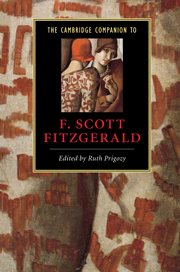Book contents
- Frontmatter
- 1 Introduction: Scott, Zelda, and the culture of celebrity
- 2 F. Scott Fitzgerald, age consciousness, and the rise of American youth culture
- 3 The question of vocation in This Side of Paradise and The Beautiful and Damned
- 4 The short stories of F. Scott Fitzgerald
- 5 The Great Gatsby and the twenties
- 6 Tender is the Night and American history
- 7 Fitzgerald’s expatriate years and the European stories
- 8 Women in Fitzgerald’s fiction
- 9 Fitzgerald’s nonfiction
- 10 Fitzgerald and Hollywood
- 11 The critical reputation of F. Scott Fitzgerald
- Bibliography
- Index
3 - The question of vocation in This Side of Paradise and The Beautiful and Damned
Published online by Cambridge University Press: 28 May 2006
- Frontmatter
- 1 Introduction: Scott, Zelda, and the culture of celebrity
- 2 F. Scott Fitzgerald, age consciousness, and the rise of American youth culture
- 3 The question of vocation in This Side of Paradise and The Beautiful and Damned
- 4 The short stories of F. Scott Fitzgerald
- 5 The Great Gatsby and the twenties
- 6 Tender is the Night and American history
- 7 Fitzgerald’s expatriate years and the European stories
- 8 Women in Fitzgerald’s fiction
- 9 Fitzgerald’s nonfiction
- 10 Fitzgerald and Hollywood
- 11 The critical reputation of F. Scott Fitzgerald
- Bibliography
- Index
Summary
The histories of composition for F. Scott Fitzgerald's first two novels, This Side of Paradise (1920) and The Beautiful and Damned (1922), resemble each other very little. This Side of Paradise was an inspired cut-and-paste job, a merging of bits and pieces of a failed novel (called “The Romantic Egotist”) with some short stories, a handful of poems, and a one-act play. Fitzgerald assembled the book during the summer of 1919 in a desperate attempt to prove himself as an author and as a prospective husband for Zelda Sayre, his golden girl. He produced the manuscript in a rush of improvisation, revised it quickly, submitted it to Charles Scribner's Sons in the early fall of 1919, had it accepted, and saw it into print the following spring.
The Beautiful and Damned, by contrast, was a carefully planned piece of literary composition. After a false start that produced “May Day”(1920), one of his finest stories, Fitzgerald settled down and wrote The Beautiful and Damned from start to finish. He sought advice about the novel from his friend Edmund Wilson and from Maxwell Perkins, his editor at Scribners, and he took their suggestions seriously, revising and polishing throughout. The narrative was serialized in Metropolitan Magazine beginning in September 1921, then published in book form in the spring of 1922. The Beautiful and Damned readsmuch more like a conventional novel than does This Side of Paradise. The narrative is coherent; the characters are consistent (as they are not in This Side of Paradise); and the themes are carefully articulated throughout. That does not make The Beautiful and Damned the better book: it lacks the verve and energy of This Side of Paradise, but it makes up for its deficiencies by providing readers with a blueprint for character types and moral questions that would preoccupy Fitzgerald for the rest of his writing career.
- Type
- Chapter
- Information
- The Cambridge Companion to F. Scott Fitzgerald , pp. 48 - 56Publisher: Cambridge University PressPrint publication year: 2001



